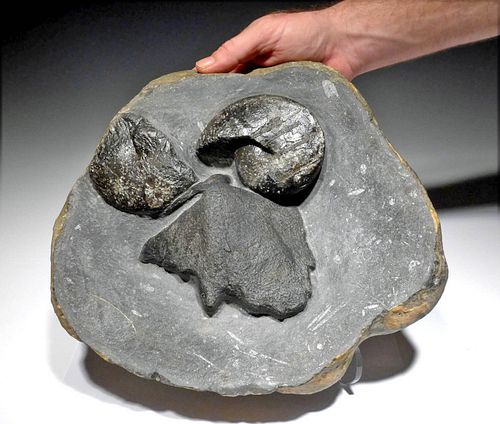Fossilized Placoderm Fish Skull w/ Goniatites Matrix
Lot 116a
About Seller
Artemis Gallery
686 S Taylor Ave, Ste 106
Louisville, CO 80027
United States
Selling antiquities, ancient and ethnographic art online since 1993, Artemis Gallery specializes in Classical Antiquities (Egyptian, Greek, Roman, Near Eastern), Asian, Pre-Columbian, African / Tribal / Oceanographic art. Our extensive inventory includes pottery, stone, metal, wood, glass and textil...Read more
Categories
Estimate:
$4,000 - $6,000
Absentee vs Live bid
Two ways to bid:
- Leave a max absentee bid and the platform will bid on your behalf up to your maximum bid during the live auction.
- Bid live during the auction and your bids will be submitted real-time to the auctioneer.
Bid Increments
| Price | Bid Increment |
|---|---|
| $0 | $25 |
| $300 | $50 |
| $1,000 | $100 |
| $2,000 | $250 |
| $5,000 | $500 |
| $10,000 | $1,000 |
| $20,000 | $2,500 |
| $50,000 | $5,000 |
| $100,000 | $10,000 |
| $200,000 | $20,000 |
About Auction
By Artemis Gallery
Mar 24, 2022
Set Reminder
2022-03-24 10:00:00
2022-03-24 10:00:00
America/New_York
Bidsquare
Bidsquare : Exceptional Antiquities Ethnographic Fine Art
https://www.bidsquare.com/auctions/artemis-gallery/exceptional-antiquities-ethnographic-fine-art-9057
Museum-worthy examples of classical antiquities (Egyptian, Greek, Roman, Near Eastern), Viking, Far East / Asian, Pre-Columbian, African / Tribal, Oceanic, Native American, Spanish Colonial, Fossils, Ancient Jewelry, Fine / Visual Arts, so much more! Artemis Gallery info@artemisgallery.com
Museum-worthy examples of classical antiquities (Egyptian, Greek, Roman, Near Eastern), Viking, Far East / Asian, Pre-Columbian, African / Tribal, Oceanic, Native American, Spanish Colonial, Fossils, Ancient Jewelry, Fine / Visual Arts, so much more! Artemis Gallery info@artemisgallery.com
- Lot Description
North Africa, Morocco, Anti-Atlas Mountains, Late Devonian, ca. 382 to 372 million years ago. An extremely rare and fascinating fossilized fragment from an armored fish skull with two goniatites resting naturally alongside in a large stone matrix- a special opportunity to acquire a specimen like this! The large skull section belongs to a Placoderm armored fish and displays the main thoracic shield / dorsal plate portion! The fossilized shells beside the fish's remains are Goniatite cephalopods (ammonoid like mollusks) that also inhabited the waters of the Devonian. A Placoderm from North Africa preserved in a large matrix with two related cephalopod fossils which it was entombed with, in such excellent condition- is remarkable! In the stone surrounding the main fossils, you can see Orthoceras fossils scattered throughout the host limestone matrix! Size (stone matrix): 11.5" L x 11.5" W (29.2 cm x 29.2 cm); (skull): 5" Diameter (12.7 cm)
Pneumatic tools and professional lab acid bath preparation has yielded the amazing detail on the Placoderm skull. Like all concretion fossils, they must be broken to see if there are any fossils inside and this specimen is no different. Fortunately, it has only a single fracture running through the skull that required no restoration or crack filling, further offering visual assurance of the 100% natural condition of the skull.
From a single plate it is difficult to determine a species, but there are scientific papers published on Placoderm from this region that could assist in researching further. Placoderm is a class of armored prehistoric fish, known from fossils, which lived from the Silurian to the end of the Devonian period. Their head and thorax were covered by articulated armored plates and the rest of the body was scaled or naked, depending on the species. Placoderms were among the first jawed fish. The first identifiable placoderms appear in the fossil record during the late Llandovery epoch of the early Silurian. The various groups of placoderms were diverse and abundant during the Devonian but became extinct at the end-Devonian Hangenberg event 358.9 million years ago. During the Devonian, placoderms went on to inhabit and dominate almost all known aquatic ecosystems, both freshwater and saltwater, but this diversity ultimately suffered many casualties during the extinction event at the Frasnian-Famennian boundary, the Late Devonian extinctions. The remaining species then died out during the Devonian/Carboniferous extinction event. Not a single placoderm species has been confirmed to have survived into the Carboniferous.
Provenance: ex-private French Collection, formed in the 1990s
All items legal to buy/sell under U.S. Statute covering cultural patrimony Code 2600, CHAPTER 14, and are guaranteed to be as described or your money back.
A Certificate of Authenticity will accompany all winning bids.
PLEASE NOTE: Due to recent increases of shipments being seized by Australian & German customs (even for items with pre-UNESCO provenance), we will no longer ship most antiquities and ancient Chinese art to Australia & Germany. For categories of items that are acceptable to ship to Australia or Germany, please contact us directly or work with your local customs brokerage firm.
Display stands not described as included/custom in the item description are for photography purposes only and will not be included with the item upon shipping.
#170566Professionally excavated and prepared. A single fissure break line running through the center of skull fossil, repaired with no restoration. 100% original fossil material and no restoration to the other fossils.Condition
- Shipping Info
-
All shipping is handled in-house for your convenience. Your invoice from Artemis Gallery will include shipping calculation instructions. If in doubt, please inquire BEFORE bidding for estimated shipping costs for individual items.
-
- Buyer's Premium



 EUR
EUR CAD
CAD AUD
AUD GBP
GBP MXN
MXN HKD
HKD CNY
CNY MYR
MYR SEK
SEK SGD
SGD CHF
CHF THB
THB
















